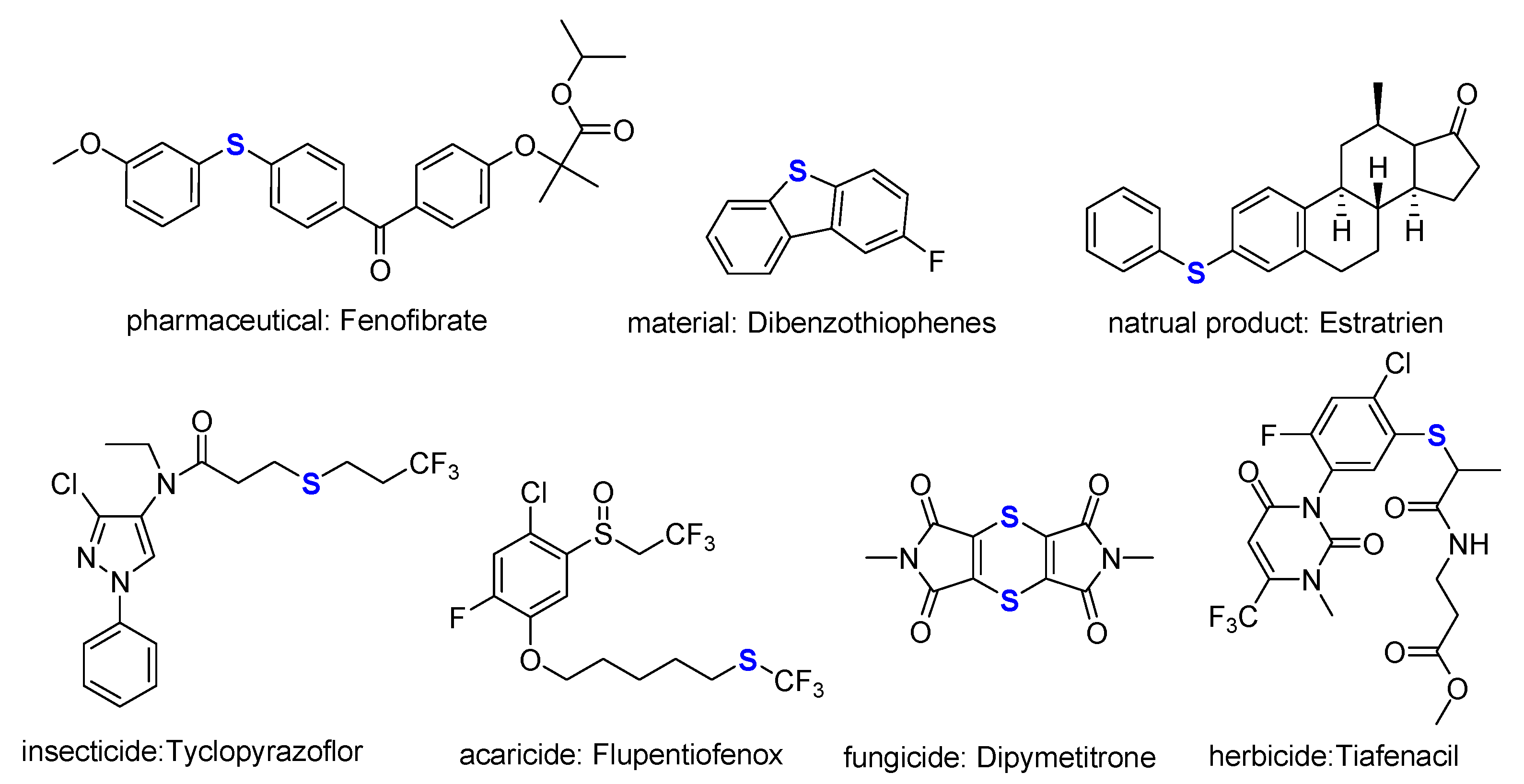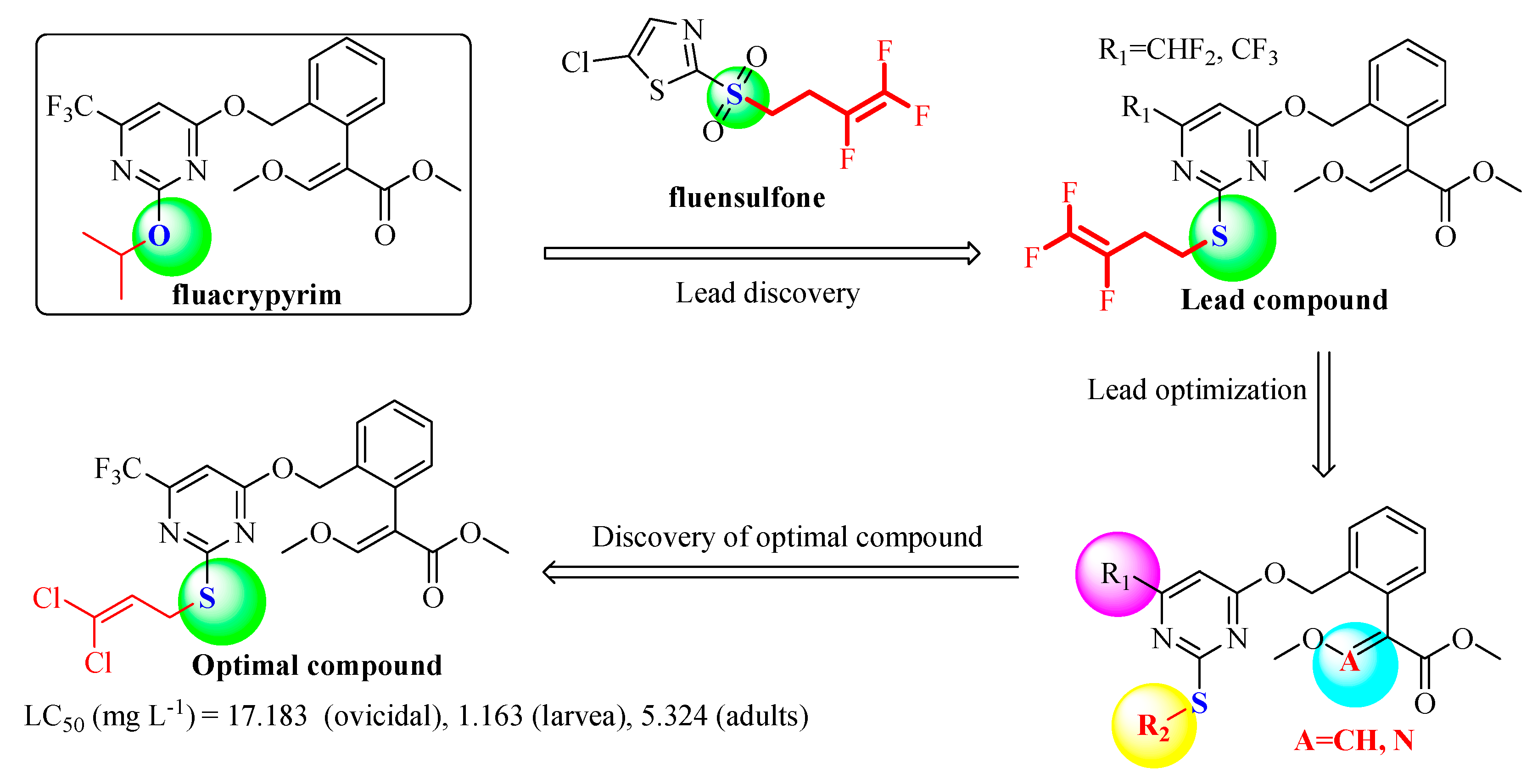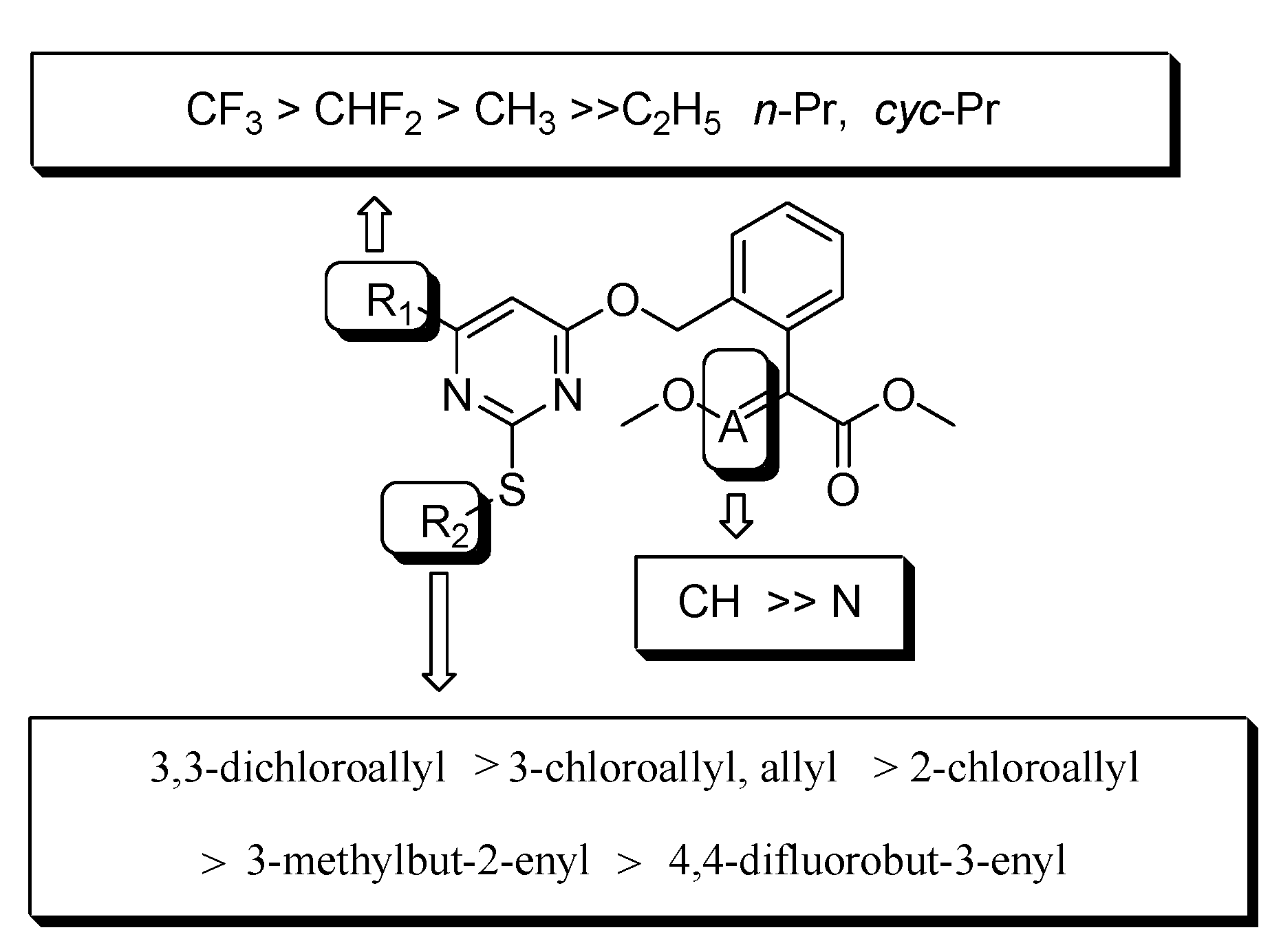Design, Synthesis, and Acaricidal Activity of Phenyl Methoxyacrylates Containing 2-Alkenylthiopyrimidine
Abstract
1. Introduction
2. Results and Discussion
2.1. Chemistry
2.2. Acaricidal Activity
2.3. Field Trials
2.4. The Toxicity of Compound 4j
3. Materials and Methods
3.1. Reagents and Instruments
3.2. Synthetic Chemistry
3.2.1. Synthesis of 6-Substituent-2-thioxo-2,3-dihydropyrimidin-4(1H)-one (1a–1f)
3.2.2. Synthesis of 2-(3,4,4-Trifluorobut-3-enylthio)-6-(trifluoromethyl)pyrimidin-4-ol (2f)
3.2.3. Synthesis of 2-(2-Chloroallylthio)-6-(trifluoromethyl)pyrimidin-4-ol (2h)
3.2.4. Synthesis of (E)-Methyl 3-methoxy-2-(2-((2-(3,4,4-trifluorobut-3-enylthio)-6-(trifluoromethyl)pyrimidin-4-yloxy)methyl)phenyl)acrylate Compound 4b
3.3. Acaricidal Activities Assay
4. Conclusions
Supplementary Materials
Author Contributions
Funding
Acknowledgments
Conflicts of Interest
References
- Chen, Q.S.; Zhao, S.; Zou, J.; Shi, L.; He, L. Monitoring of acaricide resistance in Tetranychus Cinnabarinus. Chin. J. Appl. Entomol. 2012, 4, 364–369. [Google Scholar]
- Ma, L.N.; Hu, J.H.; Lei, H.D. Research progress of botanical acaricides. Chin. Agric. Sci. Bull. 2008, 24, 377–380. [Google Scholar]
- Hua, N.Z. A review of new high efficiency and low toxicity acaricides. World Pestic. 2016, 3, 25–34. [Google Scholar]
- Van Leeuwen, T.; Vontas, J.; Tsagkarakou, A.; Dermauw, W.; Tirry, L. Acaricide resistance mechanisms in the two-spotted spider mite Tetranychusurticae and other important acari: A review. Insect Biochem. Mol. Biol. 2010, 40, 563–572. [Google Scholar] [CrossRef] [PubMed]
- Ouyang, Y.L.; Montez, G.H.; Liu, L.; Grafton-Cardwella, E.E. Spirodiclofen and spirotetramat bioassays for monitoring resistance in citrus red mite panonychus citri (Acari: Tetranychidae). Pest Manage. Sci. 2012, 68, 781–787. [Google Scholar] [CrossRef] [PubMed]
- Liang, P.; Shen, J.Z.; You, W.L. Research on advances of acaricide mechanism. Pestic. Sci. Adm. 1999, 20, 16–20. [Google Scholar]
- Mark, A.D. Review acaricide mode of action. Pest Manag. Sci. 2005, 61, 103–110. [Google Scholar]
- Van Leeuwen, T.; Tirry, L.; Yamamoto, A.; Nauen, R.; Wannes, D. The economic importance of acaricides in the control of phytophagous mites and an update on recent acaricide mode of action research. Pestic. Biochem. Physiol. 2015, 121, 12–21. [Google Scholar] [CrossRef]
- Khalighi, M.; Dermauw, W.; Wybouw, N.; Bajda, S.; Osakabe, M.; Tirrya, L.; Van Leeuwena, T. Molecular analysis of cyenopyrafen resistance in the two-spotted spider mite Tetranychus. Pest Manag. Sci. 2016, 72, 103–112. [Google Scholar] [CrossRef]
- Kramer, T.; Nauen, R. Monitoring of spirodiclofen susceptibility in field populations of European red mites, Panonychusulmi (Koch) (Acari: Tetranychidae), and the cross-resistance pattern of a laboratory-selected strain. Pest Manag. Sci. 2011, 67, 1285–1293. [Google Scholar] [CrossRef]
- Feng, K.Y.; Yang, Y.W.; Wen, X.; Ou, S.Y.; Zhang, P.; Yu, Q.; Zhang, Y.C.; Shen, G.M.; Xu, Z.F.; Li, J.H.; et al. Stability of cyflumetofen resistance in Tetranychus Cinnabarinus and its correlation with glutathione-S-transferase gene expression. Pest Manag. Sci. 2019, 75, 2802–2809. [Google Scholar] [CrossRef] [PubMed]
- Sun, X.T.; Liu, J.L.; Song, Y.Q.; Liu, S.W. Research progress on strobilurin acaricides. In Proceedings of the 14th Annual Meeting of the Pesticide Committee of the Chinese Chemical Society, Shenyang, China, 18–20 June 2010. [Google Scholar]
- Liu, C.L.; Guan, A.Y.; Liu, Z.L. The novel (E)-methyl-β-methoxyacrylate acaricides fluacrypyrim. Word Pestic. 2002, 24, 44–45. [Google Scholar]
- Beautement, K.; Clough, J.M.; de Fraine, P.J.; Godfrey, C.R.A. Fungicidal beta-methoxyacrylates: From natural products to novel synthetic agricultural fungicides. Pestic. Sci. 1991, 31, 499–519. [Google Scholar] [CrossRef]
- Chai, B.S.; Liu, C.L.; Li, H.C.; Zhang, H.; Liu, S.W.; Huang, G.; Chang, J.B. The discovery of SYP-10913 and SYP-11277: Novel strobilurin acaricides. Pest Manag. Sci. 2011, 67, 1141–1146. [Google Scholar] [CrossRef] [PubMed]
- Liu, A.P.; Wang, X.G.; Chen, C.; Pei, H.; Mao, C.H.; Wang, Y.J.; He, H.J.; Huang, L.; Liu, X.P.; Hu, Z.B.; et al. The discovery of HNPC-A3066: A novel strobilurin acaricide. Pest Manag. Sci. 2009, 65, 229–234. [Google Scholar] [CrossRef]
- Liu, C.L.; Yang, J.C. Handbook of Modern Pesticide; Chemical Industry Press: Beijing, China, 2018. [Google Scholar]
- D’Amico, J. Certain 2-(Haloalkenylthio)-4,6-dimethylpyrimidines. U.S. Parent US3557112A, 19 January 1971. [Google Scholar]
- Tetsuo, T.; Yasutomo, T.; Mitsuaki, T.; Seiji, T.; Hiroshi, H. Pyrimidinyloxyalkanamide Derivatives and Herbicide Compositions Containing Them. European Patent EP212969, 3 March 1987. [Google Scholar]
- Edwards, L.H. Fungicidal and Insecticidal 2-Thiohaloalkenyl-4-dialkoxyphosphino-thioyloxy-6-alkyl-1,3-pyrimidines. U.S. Patent US4402952A, 6 September 1983. [Google Scholar]
- Katsumi, M.; Ikumi, U.; Tsuyoshi, A.; Katsumi, F.; Yoshiyuki, K.; Norimichi, M. Preparation of Pyrimidinyloxyalkanoic Amide Derivatives as Fungicides for Agricultural and Horticultural Use. World Patent WO9818766, 7 May 1998. [Google Scholar]
- Fitzjohn, S.; Robinson, M.P.; Turnbull, M.D. Heterocyclic Compounds with Parasitical Activity. World Patent WO9406777A1, 31 March 1994. [Google Scholar]
- Turnbull, M.D. Nematicide Pyrimidine Derivatives. European Patent EP506269A1, 30 September 1992. [Google Scholar]
- Ilardi, E.A.; Vitaku, E.; Njardarson, J.T. Data-mining for sulfur and fluorine: An evaluation of pharmaceuticals to reveal opportunities for drug design and discovery. J. Med. Chem. 2014, 57, 2832–2842. [Google Scholar] [CrossRef]
- Feng, M.; Tang, B.; Liang, S.; Jiang, X. Sulfur containing scaffolds in drugs: Synthesis and application in medicinal chemistry. Curr. Top. Med. Chem. 2016, 16, 1200–1216. [Google Scholar] [CrossRef] [PubMed]
- Smith, B.R.; Eastman, C.M.; Njardarson, J.T. Beyond C,H,O, and N analysis of the elemental composition of U.S. FDA approved drug architectures. J. Med. Chem. 2014, 57, 9764–9773. [Google Scholar] [CrossRef]
- Xiong, H.Y.; Pannecoucke, X.; Besset, T. Recent advances in the synthesis of SCF2H- and SCF2FG-containing molecules. Chem. Eur. J. 2016, 22, 16734–16749. [Google Scholar] [CrossRef]
- Mishra, A.; Ma, C.Q.; Baüerle, P. Functional oligothiophenes: Molecular design for multidimensional nanoarchitectures and their applications. Chem. Rev. 2009, 109, 1141–1276. [Google Scholar] [CrossRef]
- Scott, K.A.; Njardarson, J.T. Analysis of US FDA-approved drugs containing sulfur atoms. Top. Curr. Chem. 2018, 376, 5. [Google Scholar] [CrossRef] [PubMed]
- Wang, M.; Fan, Q.; Jiang, X. Transition-metal-free diarylannulated sulfide and selenide construction via radical/anion-mediated sulfur−iodine and selenium−iodine exchange. Org. Lett. 2016, 18, 5756–5759. [Google Scholar] [CrossRef] [PubMed]
- Borthwick, A.D. 2,5-Diketopiperazines: Synthesis, reactions, medicinal chemistry, and bioactive natural products. Chem. Rev. 2012, 112, 3641–3716. [Google Scholar] [CrossRef]
- Nicolaou, K.C.; Hale, C.R.H.; Nilewski, C.; Ioannidou, H.A. Constructing molecular complexity and diversity: Total synthesis of natural products of biological and medicinal importance. Chem. Soc. Rev. 2012, 41, 5185–5238. [Google Scholar] [CrossRef]
- Liu, H.; Jiang, X. Transfer of sulfur: From simple to diverse. Chem. Asian J. 2013, 8, 2546–2563. [Google Scholar] [CrossRef]
- Davison, E.K.; Sperry, J. Natural products with heteroatom-rich ring systems. J. Nat. Prod. 2017, 80, 3060–3079. [Google Scholar] [CrossRef]
- Available online: http://www.alanwood.net/pesticides/index.html (accessed on 21 May 2020).
- Liu, C.L.; Chai, B.S. New Agrochemicals Discovery and Synthesis; Chemical Industry Press: Beijing, China, 2013. [Google Scholar]
- Lin, Y.; Zhang, S.Z.; Block, E.; Katz, L.C. Encoding social signals in the mouse main olfactory bulb. Nature 2005, 434, 470–477. [Google Scholar] [CrossRef] [PubMed]
- Nair, D.P.; Podgórski, M.; Shunsuke, C.; Gong, T.; Xi, W.X.; Fenoli, C.R.; Bowman, C.N. The thiol-Michael Addition Click Reaction: A powerful and widely used tool in materials chemistry. Chem. Mater. 2014, 26, 724–744. [Google Scholar] [CrossRef]
- Bürchstümmer, H.; Weissenstein, A.; Bilalas, D.; Würthner, F. Synthesis and characterization of optical and redox properties of bithiophene-functionalized diketopyrrolopyrrole chromophores. J. Org. Chem. 2011, 76, 2426–2432. [Google Scholar]
- Rakhimov, A.I.; Titova, E.S.; Fedunov, R.G.; Babkin, V.A. Special features of the nucleophilic substitution of halogen in alkyl and benzyl halides with anions generated from 4-hydroxy-2-mercapto-6-methylpyrimidine. Chem. Heterocycl. Compd. 2008, 44, 700–708. [Google Scholar] [CrossRef]
- Harold, W.B.; Irving, G.; Karl, D. The synthesis of 5-halogeno-2-thiouracil and 6-methyl-5-halogeno-2-thiouracil derivatives. J. Am. Chem. Soc. 1948, 70, 1753–1756. [Google Scholar]
- Uneyama, K. Organofluorine Chemistry; Blackwell: Oxford, UK, 2006. [Google Scholar]
- Kirsch, P. Modern Fluoroorganic Chemistry: Synthesis, Reactivity, Applications; Wiley-VCH: Weinheim, Germany, 2013. [Google Scholar]
- Erkin, A.V.; Krutikov, V.I.; Chubraev, M.A. Synthesis of 2-(pyrazol-1-yl)pyrimidine derivatives by cyclocondensation of ethyl acetoacetate (6-methyl-4-oxo-3,4-dihydropyrimidin-2-yl)hydrazone with aromatic aldehydes. Russ. J. Gen. Chem. 2004, 74, 423–427. [Google Scholar] [CrossRef]
- Tang, M.P.; Jia, J.X.; Xue, J.J.; Liu, J.P. Action of thiouracil derivatives as novel thermal stabilizers for poly (vinyl chloride) and the synergistic effect with calcium stearate. Russ. J. Appl. Chem. 2017, 90, 129–137. [Google Scholar] [CrossRef]
- Slivka, N.Y.; Gevaza, Y.I.; Staninets, V.I. Halocyclization of substituted 2-(alkenylthio)pyrimidin-6-ones. Chem. Heterocycl. Compd. 2004, 40, 660–666. [Google Scholar] [CrossRef]
- Yang, Z.Y.; Hao, S.L. Efficient Green Synthesis Method of Agricultural Fungicide Picoxystrobin. Chinese Patent CN104230794, 24 December 2014. [Google Scholar]
- Yasuyuki, M.; Takahiro, S.; Yutaka, I.; Hiroyuki, Y.; Makoto, F.; Mitsuru, T.; Yoshiyuki, I.; Satoru, Y.; Noriaki, K. Process for Producing Acrylic Acid Derivative. U.S. Parent US20040152894, 5 August 2004. [Google Scholar]
- Bernd, W.; Siegbert, B.; Franz, S.; Thomas, K.; Franz, R.; Eberhard, A.; Gisela, L. Preparation of (pyridinyloxy)phenylglyoxylate O-methyl Oximes as Agrochemical Fungicides. U.S. Parent US5554578, 10 September 1996. [Google Scholar]
- Sanghyuck, L.; Oh Seok, K.; Chang-Soo, L.; Won, M.; Ban, H.S.; Ra, C.S. Synthesis and biological evaluation of kresoxim-methyl analogues as novel inhibitors of hypoxia-inducible factor (HIF)-1 accumulation in cancer cells. Bioorg. Med. Chem. Lett. 2017, 27, 3026–3029. [Google Scholar]
- Xie, Y.; Xu, Y.; Liu, C.L.; Guan, A.Y.; Ban, L.F.; Ding, F.; Peng, W. Intermediate derivatization method in the discovery of new acaricide candidate: Synthesis of N-substituted piperazines derivatives and their activity against phytophagous mites. Pest Manag. Sci. 2017, 73, 945–952. [Google Scholar] [CrossRef]
Sample Availability: Samples of the compounds are not available from the authors. |





| Compd. | R1 | Appearance | m.p./°C | Yield/% | |
| 1a | CHF2 | Light yellow solid | 281.3–282.4 | 86 | |
| 1b | CF3 | Light yellow solid | 247.5–248.2 | 90 | |
| 1c | CH3 | White solid | >300 | 90 | |
| 1d | C2H5 | White solid | 226.2–228 | 87 | |
| 1e | n-Pr | White solid | 222.1–222.9 | 81 | |
| 1f | c-Pr | White solid | 241.1–243.5 | 82 | |
| Compd. | R1 | R2 | Appearance | m.p./°C | Yield/% |
| 2a | CHF2 | 4,4-difluorobut-3-enyl | Light yellow solid | 79.6–80.5 | 89 |
| 2b | CHF2 | allyl | Yellow solid | 112.0–114.7 | 84 |
| 2c | CHF2 | 2-chloroallyl | Light yellow solid | 103.7–104.3 | 79 |
| 2d | CHF2 | 3-chloroallyl | Brown solid | 106.8 | 84 |
| 2e | CHF2 | 3,3-dichloroallyl | Brown solid | 108.6 | 87 |
| 2f | CF3 | 4,4-difluorobut-3-enyl | Light yellow solid | 82.6–83.7 | 92 |
| 2g | CF3 | allyl | Light yellow solid | 132.9–133.6 | 82 |
| 2h | CF3 | 2-chloroallyl | Light yellow solid | 116.2–116.6 | 93 |
| 2i | CF3 | 3-chloroallyl | Light yellow solid | 103 | 83 |
| 2j | CF3 | 3,3-dichloroallyl | Light yellow solid | 110–111.4 | 87 |
| 2k | CF3 | 3-methylbut-2-enyl | White solid | 132.7–133.5 | 80 |
| 2l | CH3 | 3,3-dichloroallyl | White solid | 174.1–174.7 | 85 |
| 2m | C2H5 | 3,3-dichloroallyl | White solid | 118.9–120.2 | 84 |
| 2n | n-Pr | 3,3-dichloroallyl | White solid | 115.4–117.3 | 81 |
| 2o | c-Pr | 3,3-dichloroallyl | White solid | 174.3 | 82 |
| Compd. | R1 | R2 | A | Appearance/m.p./°C | Yield/% |
|---|---|---|---|---|---|
| 4a | CHF2 | 4,4-difluorobut-3-enyl | CH | Yellow oil | 84 |
| 4b | CF3 | 4,4-difluorobut-3-enyl | CH | Yellow oil | 87 |
| 4c | CHF2 | allyl | CH | White solid, 59.6–60.3 °C | 82 |
| 4d | CHF2 | 2-chloroallyl | CH | Colorless oil | 77 |
| 4e | CHF2 | 3-chloroallyl | CH | Yellow oil | 76 |
| 4f | CHF2 | 3,3-dichloroallyl | CH | Yellow oil | 80 |
| 4g | CF3 | allyl | CH | White solid, 63.4–64.8 °C | 82 |
| 4h | CF3 | 2-chloroallyl | CH | White solid, 73.8–74.9 °C | 79 |
| 4i | CF3 | 3-chloroallyl | CH | Colorless oil, | 77 |
| 4j | CF3 | 3,3-dichloroallyl | CH | White solid, 57.4–58.3 °C | 83 |
| 4k | CF3 | 3-methylbut-2-enyl | CH | Yellow oil | 75 |
| 4l | CHF2 | allyl | N | Yellow oil | 82 |
| 4m | CHF2 | 3-chloroallyl | N | Colorless oil | 88 |
| 4n | CHF2 | 3,3-dichloroallyl | N | White solid, 65.4–65.6 °C | 81 |
| 4o | CF3 | allyl | N | Yellow oil | 80 |
| 4p | CF3 | 3-chloroallyl | N | Colorless oil | 78 |
| 4q | CF3 | 3,3-dichloroallyl | N | White solid, 76.4–77.5 °C | 83 |
| 4r | CH3 | 3,3-dichloroallyl | CH | Yellow oil | 83 |
| 4s | C2H5 | 3,3-dichloroallyl | CH | Yellow oil | 80 |
| 4t | n-Pr | 3,3-dichloroallyl | CH | Yellow oil | 76 |
| 4u | cyc-Pr | 3,3-dichloroallyl | CH | Colorless oil | 81 |
| Compd. | Activities (%) against Adults at Concentration a (mg L−1) | Compd. | Activities (%) against Adults at Concentration a (mg L−1) | ||||||
|---|---|---|---|---|---|---|---|---|---|
| 500 | 100 | 20 | 4 | 500 | 100 | 20 | 4 | ||
| 4a | 90 ± 6 | 20 ± 10 | 0 | 0 | 4l | 0 | // | // | // |
| 4b | 0 | 0 | // | // | 4m | 0 | // | // | // |
| 4c | 100 ± 0 | 80 ± 3 | 80 ± 2 | 20 ± 6 | 4n | 0 | // | // | // |
| 4d | 90 ± 8 | 100 ± 0 | 50 ± 3 | 0 | 4o | 100 ± 0 | 60 ± 6 | 30 ± 4 | 30 ± 7 |
| 4e | 100 ± 0 | 80 ± 2 | 20 ± 7 | 0 | 4p | 0 | // | // | // |
| 4f | 100 ± 0 | 80 ± 4 | 80 ± 5 | 20 ± 7 | 4q | 30 ± 8 | // | // | // |
| 4g | 100 ± 0 | 50 ± 7 | 0 | 0 | 4r | 0 | // | // | // |
| 4h | 100 ± 0 | 90 ± 5 | 50 ± 6 | 0 | 4s | 0 | // | // | // |
| 4i | 100 ± 0 | 100 ± 0 | 80 ± 10 | 70 ± 7 | 4t | 0 | // | // | // |
| 4j | 100 ± 0 | 100 ± 0 | 80 ± 2 | 80 ± 4 | 4u | 0 | // | // | // |
| 4k | 100 ± 0 | 100 ± 0 | 80 ± 3 | 0 | fluacrypyrim | 100 ± 0 | 100 ± 0 | 80 ± 5 | 40 ± 7 |
| Compd. | Adults | Larvae a | Ovicidal | |||
|---|---|---|---|---|---|---|
| LC50 (mg L−1) | 95% Confidence Interval | LC50 (mg L−1) | 95% Confidence Interval | LC50 (mg L−1) | 95% Confidence Interval | |
| 4i | 138.626 | 122.279–158.246 | - | - | 146.465 | 115.367–189.178 |
| 4j | 5.324 | 3.209–7.375 | 1.163 | 1.037–1.302 | 17.183 | 13.903–21.257 |
| Fluacrypyrim | 4.178 | 1.203–7.112 | 2.009 | 1.777–2.297 | 43.332 | 32.444–63.118 |
| Compd. | Concentration (mg L−1) | Effect on Controlling Panonychuscitri(%) | |||||||
|---|---|---|---|---|---|---|---|---|---|
| 3 days | sig. | 7 days | sig. | 10 days | sig. | 20 days | sig. | ||
| 98% 4j | 100 | 96.61 | a | 97.36 | b | 96.25 | a | 81.02 | a |
| cyetpyrafen | 100 | 97.70 | a | 100.00 | a | 99.38 | a | 89.79 | a |
| cyenopyrafen | 100 | 92.26 | a | 97.85 | b | 96.43 | a | 80.87 | b |
| Acute Toxicity Test | Species | Results |
|---|---|---|
| Oral LD50 (mg/kg) | Rat | >500 (female) |
| Oral LD50 (mg a.i./kg) | Coturnix japonica | >2090 |
| Oral 48 h LD50 (µg a.i./honeybee) | Apismellifera L. | >116 |
| Eye irritation | Rabbit | Moderate irritation |
© 2020 by the authors. Licensee MDPI, Basel, Switzerland. This article is an open access article distributed under the terms and conditions of the Creative Commons Attribution (CC BY) license (http://creativecommons.org/licenses/by/4.0/).
Share and Cite
Hao, S.; Cai, Z.; Cao, Y.; Du, X. Design, Synthesis, and Acaricidal Activity of Phenyl Methoxyacrylates Containing 2-Alkenylthiopyrimidine. Molecules 2020, 25, 3379. https://doi.org/10.3390/molecules25153379
Hao S, Cai Z, Cao Y, Du X. Design, Synthesis, and Acaricidal Activity of Phenyl Methoxyacrylates Containing 2-Alkenylthiopyrimidine. Molecules. 2020; 25(15):3379. https://doi.org/10.3390/molecules25153379
Chicago/Turabian StyleHao, Shulin, Zengfei Cai, Yangyang Cao, and Xiaohua Du. 2020. "Design, Synthesis, and Acaricidal Activity of Phenyl Methoxyacrylates Containing 2-Alkenylthiopyrimidine" Molecules 25, no. 15: 3379. https://doi.org/10.3390/molecules25153379
APA StyleHao, S., Cai, Z., Cao, Y., & Du, X. (2020). Design, Synthesis, and Acaricidal Activity of Phenyl Methoxyacrylates Containing 2-Alkenylthiopyrimidine. Molecules, 25(15), 3379. https://doi.org/10.3390/molecules25153379






